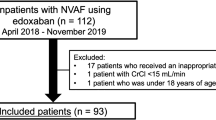Abstract
Objectives
The aim of this study was to evaluate the activity of anti-activated factor X (anti-Xa) in patients with different degrees of chronic renal failure (CRF), treated with therapeutic doses of low molecular weight heparin.
Design
This prospective study evaluated the effect of age, renal function, BMI, gender, in determining the efficacy and safety of treatment with enoxaparin, evaluated by assessing the anti-Xa. The therapeutic anticoagulant range was set between 0.20 and 0.70 U/mL.
Setting
Two hospital geriatric units.
Participants
98 patients (64 men, 34 women, mean age 82 years) with CRF, treated with enoxaparin at therapeutic dosage, for deep vein thrombosis or acute coronary syndrome.
Measurements
Anti-Xa was assessed 4 h after the third administration of LMWH using Chromogenix test. Renal function was assessed by calculating creatinine clearance according to Cockcroft formula.
Results
The dose of enoxaparin ranged between 53 and 200 U/kg; total 4000–16000 U/day. The mean anti-Xa was 0.41 U/mL (95% CI 0.36–0.45). Multiple regression analysis selected only the dose of enoxaparin, but not age, creatinine clearance, BMI, gender, as a predictor of anti-Xa serum levels. In seven patients anti-Xa was above the range but none of them received more than 150 U/Kg enoxaparin (100 U/kg if creatinine clearance <30 mL/min). Ten patients (eight men, two women) showed suboptimal levels of anti-Xa, regardless enoxaparin dose or creatinine clearance.
Conclusion
Enoxaparin dose reduction according to renal function decreases the risk of overdosing and potentially the risk of bleeding. The risk of under dosing seems less predictable; therefore, anti-Xa assay may be useful in severe clinical situations that require higher anticoagulant activity.


Similar content being viewed by others
References
Hirsh J, Bauer KA, Donati MB et al (2008) American college of chest physicians. Parenteral anticoagulants: American college of chest physicians evidence-based clinical practice guidelines (8th edition). Chest 133:141 S–159 S
Hulot JS, Vantelon C, Urien S et al (2004) Effect of renal function on the pharmacokinetics of enoxaparin and consequences on dose adjustment. Ther Drug Monit 26:305–310
Bazinet A, Almanric K, Brunet C et al (2005) Dosage of enoxaparin among obese and renal impairment patients. Thromb Res 116:41–50
Al-Sallami HS, Medlicott NJ (2014) Investigation of an anti-activated factor X (anti-Xa) assay for the quantification of enoxaparin in human plasma. J Pharm Pharmacol 67:209–214
Drinka PJ, Langer E (1989) The Cockroft–Gault formula. J Am Geriatr Soc 37:820
Smythe MA, Priziola J, Dobesh PP et al (2016) Guidance for the practical management of the heparin anticoagulants in the treatment of venous thromboembolism. J Thromb Thrombolysis 41:165–186
DeCarolis DD, Thorson JG, Clairmont MA et al (2012) Enoxaparin outcomes in patients with moderate renal impairment. Arch Intern Med 172:1713–1718
Barras MA, Dufful SB, Atherton JJ et al (2008) Individualized compared with conventional dosing of enoxaparin. Clin Pharmacol Ther 83:882–888
Green B, Greenwood M, Saltissi D et al (2005) Dosing strategy for enoxaparin in patients with renal impairment presenting with acute coronary syndromes. Br J Clin Pharmacol 59:281–290
Kruse MW, Lee JJ (2004) Retrospective evaluation of a pharmacokinetic program for adjusting enoxaparin in renal impairment. Am Heart J 148:582–589
Lim W, Dentali F, Eikelboom JW et al (2006) Meta-analysis: low-molecular-weight heparin and bleeding in patients with severe renal insufficiency. Ann Intern Med 144:673–684
Sacha GL, Greenlee KM, Ketz JM (2016) The use of anti-factor Xa monitoring in a selection of patients receiving enoxaparin at a large academic medical center. J Thromb Thrombolysis 42:479–485
Clark NP (2008) Low-molecular-weight heparin use in the obese, elderly, and in renal insufficiency. Thromb Res 123:S58–S61
Michels WM, Grootendorst DC, Verduijn M et al (2010) Performance of the Cockcroft–Gault, MDRD, and new CKD-EPI formulas in relation to GFR, age, and body size. Clin J Am Soc Nephrol 5:1003–1009
Author information
Authors and Affiliations
Corresponding author
Ethics declarations
Conflict of interest
On behalf of all authors, the corresponding author states that there is no conflict of interest.
Informed consent
A written informed consent was obtained in all the participants, study protocol was approved by our Institution Ethical Committee.
Rights and permissions
About this article
Cite this article
Pellizzari, L., Facchinetti, R., Corrà, L. et al. Can we reliably predict the level of anticoagulation after enoxaparin injection in elderly patients with renal failure?. Aging Clin Exp Res 30, 605–608 (2018). https://doi.org/10.1007/s40520-017-0822-8
Received:
Accepted:
Published:
Issue Date:
DOI: https://doi.org/10.1007/s40520-017-0822-8




